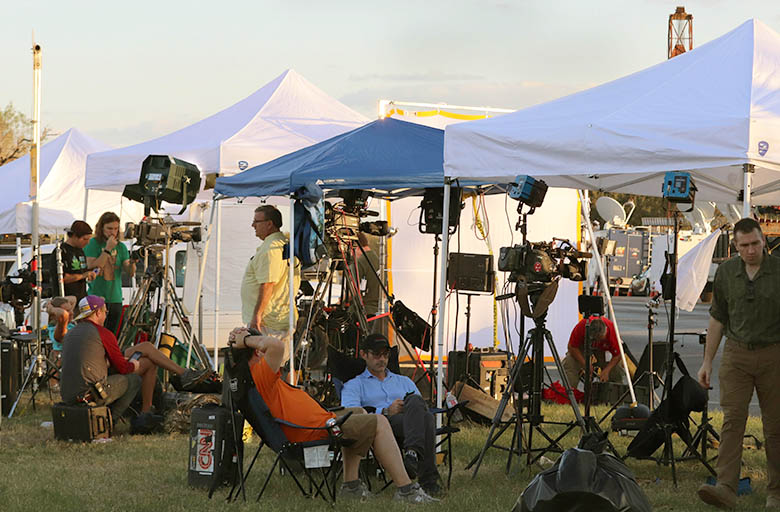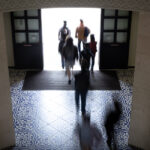The asphalt streets are weather-beaten, their cracks revealing the red clay earth beneath. Weeds jut up through cracks in the concrete near rusted stop signs, implying a certain agrarian connection this rural Texas town holds dear to heart.
The odor of barbecue wafts and hangs in the humid air, so thick and inviting it’s as though one could slice the sky and serve a three-piece brisket plate with a large mason jar of sweet iced tea.
Wood façade homes hide behind veils of dirt and mold, their chain link fences protruding out like ragged swords. Here and there, broken windows betray the financial station of the sleepy little town on U.S. Highway 87.
Like most American pop songs, each beat in Sutherland Springs proceeded to the next in an all-too-predictable manner. That was until a masked man, clad in black, opened fire on a small Baptist church, killing 26 people and injuring another 20. In the wake of the unimaginable horror, the entire world descended upon an unprepared community.
First, the local sheriff’s department and volunteer firefighters arrived, treating survivors and victims of the deadliest mass shooting in modern Texas history. This was followed by a wave of other first responders from neighboring communities.
Finally, the flood waters were opened and within a half hour a rush of three-lettered agencies and media descended on the small rural town.
“Masked gunman kills in attack on rural Texas church,” the first headline read.
For a student journalist covering his first national level story, the experience was altogether exciting, sobering, fast moving and disgusting.
On the scene from Sunday through Wednesday, the experience was eye opening and invaluable. I saw the pressures facing the media firsthand, but also the insensitive distance maintained for impartiality. I saw the tough decisions faced on media row, and the split-second judgment calls.
One example came moments before Vice President Pence was scheduled to speak from Sutherland Springs on Wednesday. Cell phones began ringing throughout the press box as breaking news on a potential active shooter in Floresville left many with a tough decision: cover the vice president or race for Floresville.
By sunrise on the second day, the politicians made their way to Sutherland Springs, each with pre-written promises of remembrance for the dead and prayers for the living, before returning to their nice offices far away from the hayfields and dirt roads of a mourning town.
Before the clocks struck midnight on the second day, hosts of opportunistic organizations, companies, charlatans, and crazies were on scene — each offering their unique services in exchange for a few moments of national camera time.
One man, who told me that he was released that very morning from a mental health facility, made his way down the nearly mile-long train of media in search of someone to share his story with, before being escorted off under the watchful eye of FBI agents and Texas Rangers.
In a rural town of about 500, the influx of volunteers and media equaled – if not surpassed – the total population. In fact, calling Sutherland Springs a town feels like a lie. It’s a hamlet.
For residents, and most Americans, the evil that came to Sutherland Springs has been hard to comprehend. Time, and time alone, can heal the wounds created by the tragic and heinous events that took place at the First Baptist Church. That is why, in this student journalist’s experience, the actions of the media in Sutherland Springs were questionable and borderline immoral.
“I even had questions for some of the FBI agents in here interviewing people when I asked if this was normal, and they said this is beyond the norm,” said Chris Taylor, a small business owner in Sutherland Springs.
“I can tell you that more than a mile in either direction from the church on both sides of the street has been media. The number of media outnumbered residents five-to-one,” Taylor said.
[metaslider id=27477]
According to the American Psychological Association, a lack of quality sleep can exacerbate trauma and make it harder to maintain emotional balance.
The sheer number of media present in Sutherland Springs disrupted day to day activities of the small rural town, and the 24-hour a day movement and broadcasts made the noise levels too much for many residents.
“My one year old can’t sleep because of all the noise,” said Chris Spear, a resident whose mobile home rests against the cordoned crime scene and massive media presence. “If he’s up, we’re up.”
In response, in a span of a single day, countless “No Trespassing” signs began to sprout up in yards and on fences throughout the town. Residents were bombarded by cameras and questions, and were becoming agitated.
Like a scene from ‘Stranger Things,’ it wasn’t uncommon to witness vans roaming the streets of Sutherland Springs on a near continual basis in search of a story.
When one resident came out of her home, for a few seconds of fresh air, the audible screech of tires from vans coming to a stop could be heard for blocks, as journalists from a Japanese news network rushed forward with cameras and microphones. “Did you know anyone who was killed in the shooting?” they yelled to the stunned resident.
My heart sank.
Occasionally, word would reach the media that a scrum was to take place at the crime scene and the streets of Sutherland Springs would empty for a few moments as journalists rushed to the site of the press conference for the latest information.
As a student journalist, it was at these times that I witnessed the hankering appetites consume the crowd, as the swarm of journalists jockeyed with one another for the best shot.
On Monday, a day after the mass shooting, I took the front row representing my campus’ digital outlet, shoulder to shoulder with our media mentors from The Houston Chronicle and CBS news.
Late to the show, a cameraman and boom mic operator from the Associated Press began walking the line in search of a media outlet they could bully. When they noticed the student media press pass, they literally pushed in front of me without so much as an apology and with a half-hearted explanation.
“We’re going live, we have to get the shot!” the cameraman said dismissively.
This wouldn’t be the first such experience, nor the last. By the end of the week, I picked up on the bad habits and lack of camaraderie prevalent at the site, often engaging in the same unethical behavior as my professional counterparts.
Following the lead of the professionals, I found myself ignoring certain people and focusing on those that fit a certain “feel” for the story.
Why interview the well-spoken business owner, when you can interview the cowboy boot wearing, Whataburger loving, tweety-bird shirt wearing woman spitting Copenhagen in the grass at the post office?
After a few such interviews, this student journalist can say that he’s ashamed to follow such a poor example from supposed mentors.
“I have been interviewed by, or even approached by NO camera. But my employees or some of the more downtrodden of our community have had cameras shoved in their faces because that makes it more interesting,” Taylor said, as his well dressed and eloquent nature didn’t fit the story the camera lens had been trained to tell.
Leaving Sutherland Springs after this week, a realization occurred. The responsibility of the media is to tell the story, to inform our readers, viewers and listeners of the goings-on across the US. That is a long held function of journalism, and one that is fundamental in a free democracy.
At what point, however, do we as members of the media weigh the damage we cause in such a pursuit? How do we balance telling a story with the causing of tangible harm?
These are questions I don’t have an answer for, but must be discussed by our leading professionals in the industry to ensure that we aren’t causing more harm than good. Perhaps, until we as a society can take the steps needed to curb the constant violence this type of behavior will continue to occur. Maybe, only through our chronicling and tough questions can any hope for a real solution come to pass.
The Mesquite can’t speak on behalf of an entire profession, but at the very least, this student journalist can say this: I’m sorry Sutherland Springs.






